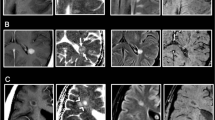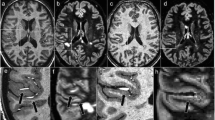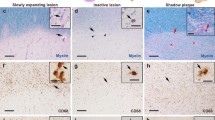Abstract
Ring-enhancing lesions seen on MR images can occur with a variety of etiologies. Some ring-enhancing lesions have hypointense rims peripherally on T2-weighted MR images. In this study, we examined whether T2 hypointense rims were associated with specific pathologies. A search for ring-enhancing lesions on MR images obtained from 1996 to 2004 was performed, and revealed 221 patients with MRI findings of ring enhancement. The pattern of T2 hypointensity (arc or rim) corresponding with ring enhancement was recorded. In addition, we analyzed other imaging characteristics, including signal on diffusion-weighted images, central homogeneity on T2 and multiplicity of lesions. We then reviewed clinical data on the patients to ascertain the diagnosis for each examination. The most common associated pathologies in our study were gliomas (40%), metastases (30%), abscesses (8%) and multiple sclerosis (MS; 6%). Hypointense borders on T2-weighted images were present in 67% of lesions in the form of a rim in 40% and an arc in 60%. Abscesses had the highest percentage of hypointense rims. Metastases and gliomas more commonly had arcs, and MS lesions were divided between rims and arcs. Abscesses and MS lesions were more commonly homogeneous centrally, compared to gliomas and metastases. Additionally, abscesses were more often bright on diffusion imaging than the other pathologies. As expected, abscesses and MS lesions were usually multiple, whereas metastases were typically multiple in approximately 50% of the patients; gliomas were generally solitary. Trends in T2 hypointensity may aid in distinguishing among etiologies of ring-enhancing lesions, although there is overlap between the MR appearance of these various pathologies.




Similar content being viewed by others
References
Haimes AB, Zimmerman RD, Morgello S, et al (1989) MR imaging of brain abscesses. AJR Am J Roentgenol 152:1073–1085
Yetkin Z, Haughton VM (1995) Atypical demyelinating lesions in patients with MS. Neuroradiology 37:284–286
Gomori JM, Grossman RI, Goldberg HI, Zimmerman RA, Bilaniuk LT (1985) Intracranial hematomas: imaging by high-field MR. Radiology 157:87–93
Atlas SW, Grossman RI, Gomori JM, et al (1987) Hemorrhagic intracranial malignant neoplasms: spin-echo MR imaging. Radiology 164:71–77
Gupta RK, Jena A, Sharma A, et al (1988) MR imaging of intracranial tuberculomas. J Comput Assist Tomogr 12:280–285
Desprechins B, Stadnik T, Koerts G, et al (1999) Use of diffusion-weighted MR imaging in differential diagnosis between intracerebral necrotic tumors and cerebral abscesses. AJNR Am J Neuroradiol 20:1252–1257
Guo AC, Provenzale JM, Cruz LCH Jr, Petrella JR (2001) Cerebral abscesses: investigation using apparent diffusion coefficient maps. Neuroradiology 43:370–374
Okamoto K, Ito J, Ishikawa K, Sakai K, Tokiguchi S (2000) Diffusion-weighted echo-planar MR imaging in differential diagnosis of brain tumors and tumor-like conditions. Eur Radiol 10:1342–1350
Noguchi K, Watanabe N, Nagayoshi T, et al (1999) Role of diffusion-weighted echo planar MRI in distinguishing between brain abscess and tumour: a preliminary report. Neuroradiology 41:171–174
Ray S, Kundu B, Kundu S, Roy S, Sharma SK (2002) Distinguishing neoplastic and non-neoplastic ring enhancing lesions of the brain detected in CT and/or MRI with the help of correlative nuclear imaging. Ind J Radiol Imag 12:189–195
Messerschmidt A, Prayer D, Olischar M, Pollak A, Birnbacher R (2004) Brain abscesses after Serratia marcescens infection on a neonatal intensive care unit: differences on serial imaging. Neuroradiology 46:148–152
Masdeu JC, Quinto C, Olivera C, et al (2000) Open-ring imaging sign: highly specific for atypical brain demyelination. Neurology 54:1427–1433
Acknowledgements
We are grateful for the assistance of Sandra C. Bryant. Department of Statistics. Mayo Clinic. Rochester, MN 55905.
Author information
Authors and Affiliations
Corresponding author
Rights and permissions
About this article
Cite this article
Schwartz, K.M., Erickson, B.J. & Lucchinetti, C. Pattern of T2 hypointensity associated with ring-enhancing brain lesions can help to differentiate pathology. Neuroradiology 48, 143–149 (2006). https://doi.org/10.1007/s00234-005-0024-5
Received:
Accepted:
Published:
Issue Date:
DOI: https://doi.org/10.1007/s00234-005-0024-5




